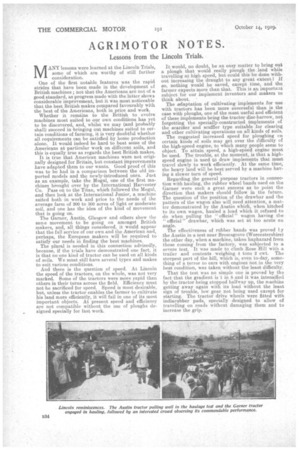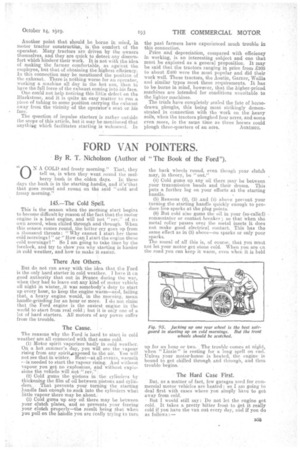AGRIMOTOR NOTES.
Page 20

Page 21

If you've noticed an error in this article please click here to report it so we can fix it.
Lessons from the Lincoln Trials.
MANY lessons were learned at the Lincoln Trials, some of which are worthy of still further consideration. One of the first notable features was the rapid. strides that have been made in the development of British machines ; not that the Americans are not of a good standard, as progress made with the latter shows considerable.iraprovernent, but it was most noticeable that the best British makes compared favourably with the best of the Americans, both in price and work.
Whether it remains to the British to evolve machines most suited to our own conditions has yet to be discovered, and,. whilst we may (and Probably shall) succeed in bringing out machines suited to certain conditions of farming, it is very doubtful whether all requirements can be satisfied by home production. alone. It would indeed be hard to beat some of the Americans at particular work on 'different soils, and this is equally true as regards the best British makes. It is true that American machines were not originally designed for Britain, but constant improvements have adapted them to our wants. Good proof of this was to be had in a comparison between the old imported models and the newly-introduced ones. Just as an example, take the Mogul, one of the first machines brought over by the International Harvester Co. Pass on to the Titan, which followed the Mogul, and then look at the International Junior, a machine suited both in work and price to the needs of the average farm of 200 to 300 acres of light or Moderate soil, and one has the idea of the kind of movement that is going on. The Garner, Austin, Glasgow and others show the same movement to be going on amongst British makers, and, all things considered, it would appear that the full service of our own and the American and, perhaps, the European makers will be required to satisfy our needs in finding the best machines. The plural is needed in this connection advisedly, because, if the trials have 'demonstrated one fact, it is that no one kind of tractor can be used on all kinds of soils. We must still have several types and makes to suit various conditions.
And there is the question of speed. At Lincoln the speed of the tractors, on the whole, was not very marked. Some of the tractors were more rapid than others in their turns across the field. Efficiency must not be sacrificed for speed. Speed is most desirable, but, unless the tractor enables the farmer to cultivate his land more efficiently, it will fail in one of its most important objects. At present speed and efficiency are not compatible without the use of ploughs designed specially for fast work. It would, no doubt, be an easy matter to bring out a plough that would really plough the land while travelling at high speed, but could this be done without increasing the draught to any great extent ? If ao, nothing would be saved, except time, and the farmer expects more than that. This is an important subject for our implement inventors and makers to think about.
The adaptation of cultivating implements for use with tractors has been more successful than is the case with ploughs one of the most useful and efficient of these implements being the tractor disc-harrow, not forgetting the specially' constructed implements of the scarifier and scuffles type suitable for clearing and other cultivating operations on all kinds of soils. The suggested increased speed for ploughing on certain kinds of soils may get over the difficulty of the high-speed engine, to which many people seem to object. To attain speed, a high-speed engine must be used. The trouble, at the moment, is that a highSpeed engine is used to draw implements that must travel slowly to work efficiently. At the same time, the heavy land will be best served by a machine having a slower turn of speed.
Regarding. the general purpose tractors in connection with hauling, the rubber wheel bands used on the Garner were such a great success as to point the direction that makers should follow in the future. The question of the position of the drawbar and the pattern of the wagon also will need attention, a matter demonstrated by the Austin which, when hitched to its own wagon, hauled a load which it refused to do when pulling the " official " wagon having the " official " drawbar, which was set at too acute an angle.
The effectiveness of rubber bands was proved Ly the Austin in a test near Bromsgrove (Worcestershire) the other day, when a machine, taken haphazard from those corning from the factory, was subjected to a severe test. It was made to climb Rose Hill with a trailer and contents weighing 4 tons 2 cwt. The steepest part of the hill, which is, even to-day, something of a terror to cars with engines not in the very best condition, was taken without the least difficulty.
That the test was no simple one is proved by the fact that the gradient is 1 in 8 and it was intensified by the tractor being stopped halfway up, the machine getting away again with its load without the least sign of trouble, low gear not being used except for starting. The tractor drive wheels were fitted with indiarubber pads, specially designed to allow of travelling on roads without damaging them and to increase the grip. Another point that should be borne in mind, in motor tractor construction, is the 'comfort of the operator. Many tractors are driven by the owners themselves, and they are quick to detect any discomfort which 'hinderstheir work. It is not with the idea of making the farmer comfortable, as against the employee, but that of obtaining the highest, efficiency. In this connection may be mentioned the position of the exhaust... There is nothing worse for an operator, working a machine all day in the hot sun, than to have the full force of the exhaust coming into his face.
One could not help noticing this little defect on the Blackstone, and it is quite an easy matter to run a piece of tubing to some position carrying the exhaust away from the vicinity of the 9perator's seat or his face.
The question of impulse starters is rather outside the scope of this article, but it may be mentioned that anything which facilitates starting is welcomed. In
the past farmers have experienced much trouble in this connection.
Price and depreciation, compared with efficiency in working, is an interesting subject and one that must be explored as a general proposition. It may be said that the tractors ranging in price from £300 to about £400 were the most popular and did their work well. These tractors, the Austin, Garner, Wallis and similar types meet these requirements. It has to be borne in mind, however, that the higher-priced machines are intended for conditions unsuitable to the lighter machines.
The trials have completely sealed the fate of horsedrawn ploughs, this being most strikingly demonstrated in connection with the work on the heavy soils, when the tractors ploughed four acres, and some even more, in the 'same time as three horses could plough three-quarters of an acre. Annum.
























